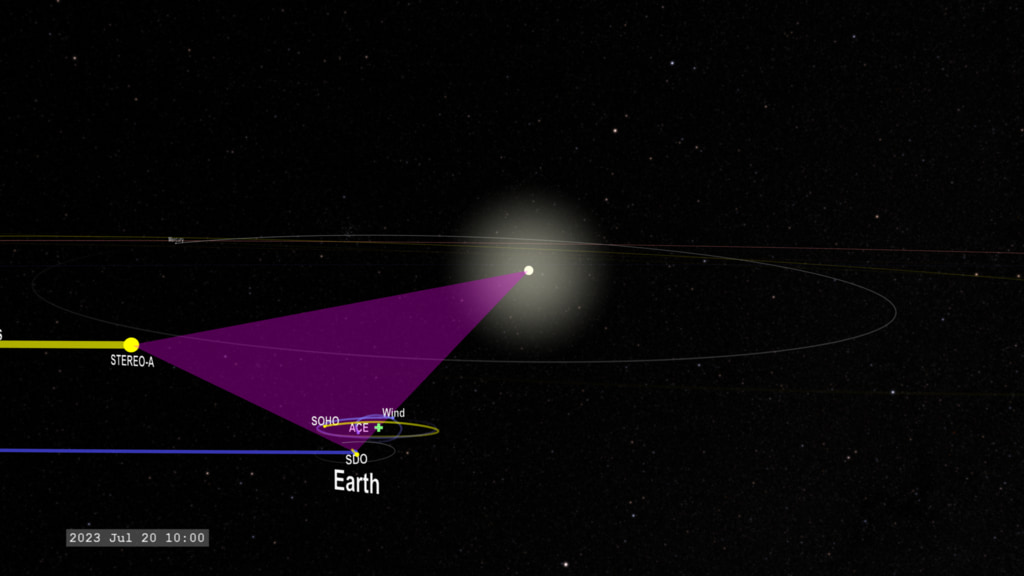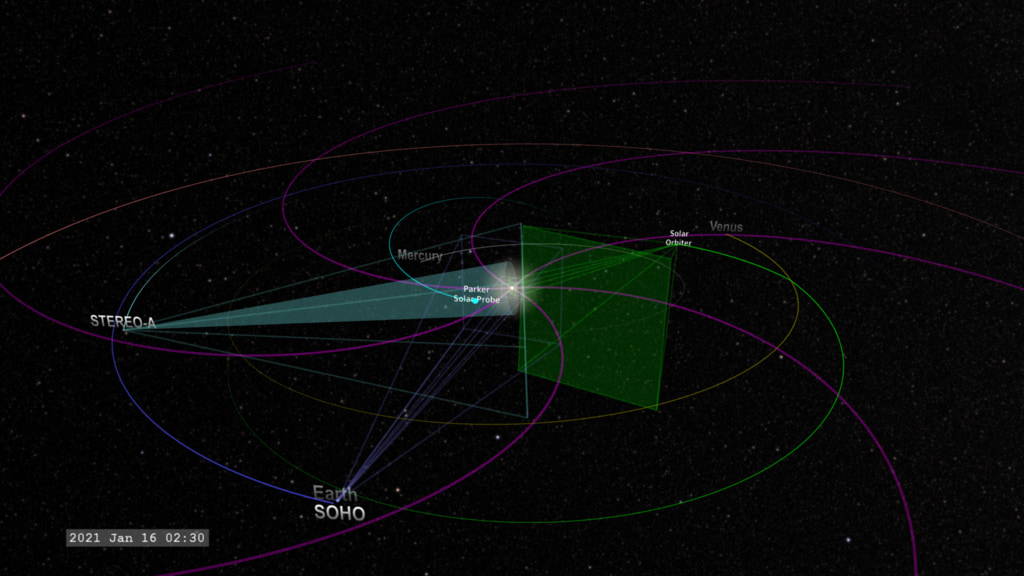The Many Eyes on the Parker Solar Probe Perihelion (February 2022)
This visualization opens with a top-down view, then transtions to an oblique view of the inner solar system with the various solar-observing missions conducting coordinated observations of the plasma environment. This version displays the imaging instrument camera frustums and solar magnetic field alignments - the 'glyph' version. A version with just the orbits, no 'glyphs' is available in the [Download Options] menu.
In these visualizations, we show the orbits of the inner planets, along with orbits of multiple solar missions: Parker Solar Probe, Solar Orbiter, STEREO-A and SOHO at the Earth-Sun L1 Lagrange point.
These visualizations are focussed around the time of February 25, 2022, the time of Parker Solar Probe reaching perihelion in full view of Solar Orbiter, STEREO-A, SOHO, and Earth-based telescopes.
There are two versions of each visualization. One version shows JUST the spacecraft and planetary orbits. The other version shows the view frustums of the imagers along with the solar magnetic field and magnetic conjunctions.
Spacecraft doing imaging have a semi-transparent conical or rectangular frustum representing the field of view of the camera.
The Parker spiral created by the solar magnetic field is represented by the magenta spiral lines emanating out from and rotating with the Sun.
During these encounters, spacecraft conducting in situ measurements are highlighted.
In addition to direct 'line-of-sight' conjunctions, the spacecraft can have 'magnetic' conjunctions where they are both crossing the same outward magnetic field line in the solar wind. This configuration is represented by a wide magenta band, spiraling along lines similar to the solar magnetic field lines. The bands are represented as broad since the precise timing of these alignments may depend on local conditions such as the solar wind speed. In these configurations, it is hoped to compare charged particle flows along the solar magnetic field lines.
In many encounters, the imaging is performed while another spacecraft is passing through the camera field of view conducting in situ measurements. Those images will provide a global view of the region through which the spacecraft is traversing, providing additional context for interpreting the in situ data.
This visualization presents an oblique view of the inner solar system with the various solar-observing missions conducting coordinated observations of the plasma environment. This version displays the imaging instrument camera frustums and solar magnetic field alignments - the 'glyph' version. A version with just the orbits, no 'glyphs' is available in the [Download Options] menu.
This visualization presents a top-down view of the inner solar system with the various solar-observing missions conducting coordinated observations of the plasma environment. This version displays the imaging instrument camera frustums and solar magnetic field alignments - the 'glyph' version. A version with just the orbits, no 'glyphs' is available in the [Download Options] menu.
Credits
Please give credit for this item to:
NASA's Scientific Visualization Studio
-
Visualizer
- Tom Bridgman (Global Science and Technology, Inc.)
-
Producer
- Joy Ng (KBR Wyle Services, LLC)
-
Technical support
- Laurence Schuler (ADNET Systems, Inc.)
- Ian Jones (ADNET Systems, Inc.)
Release date
This page was originally published on Friday, February 25, 2022.
This page was last updated on Monday, July 15, 2024 at 12:09 AM EDT.
Missions
This visualization is related to the following missions:Datasets used in this visualization
-
JPL/Horizon Orbital Ephemerides
ID: 597Planetary ephemerides
This dataset can be found at: http://ssd.jpl.nasa.gov/?horizons
See all pages that use this dataset
Note: While we identify the data sets used in these visualizations, we do not store any further details, nor the data sets themselves on our site.

